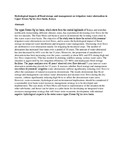| dc.contributor.author | Ngigi, Stephen N | |
| dc.contributor.author | Savenije, Hubert H. G | |
| dc.contributor.author | Gichuki, Francis N | |
| dc.date.accessioned | 2013-06-22T09:09:57Z | |
| dc.date.available | 2013-06-22T09:09:57Z | |
| dc.date.issued | 2008 | |
| dc.identifier.citation | Stephen N. Ngigi, Hubert H. G. Savenije, Francis N. Gichuki (2008). Hydrological impacts of flood storage and management on irrigation water abstraction in Upper Ewaso Ng'iro river basin, Kenya. Water Resources Management December 2008, Volume 22, Issue 12, pp 1859-1879 | en |
| dc.identifier.uri | http://link.springer.com/article/10.1007/s11269-008-9257-5 | |
| dc.identifier.uri | http://erepository.uonbi.ac.ke:8080/xmlui/handle/123456789/38072 | |
| dc.description.abstract | The upper Ewaso Ng’iro basin, which starts from the central highlands of Kenya and stretches northwards transcending different climatic zones, has experienced decreasing river flows for the last two decades. The Naro Moru sub-basin is used to demonstrate the looming water crisis in this water scarce river basin. The objective of the study was to show the extent of dry seasons’ irrigation water abstractions on river flows, and to assess the hydrological impact of flood storage on temporal water distribution and irrigation water management. Decreasing river flows are attributed to over-abstraction mainly for irrigating horticultural crops. The number of abstractors has increased four times over a period of 10 years. The amount of water abstracted has also increased by 64% over the last 5 years. Moreover, the proportion of unauthorized abstractions has been increasing over the years, currently at about 80% and 95% during high and low flows respectively. This has resulted in alarming conflicts among various water users. The situation is aggravated by low irrigation efficiency (25–40%) and inadequate flood storage facilities. The paper analyzes over 40 years’ observed river flow data and 5-year interval water abstraction monitoring records for 15 years. It assesses whether flood storage and management, can reduce dry seasons’ irrigation water abstractions without significantly reducing river flows to affect the sustenance of natural ecosystems downstream. The results demonstrate that flood storage and management can reduce water abstraction and increase river flows during the dry seasons, without significantly reducing high flows to affect the downstream water users. However, socio-economic, hydrological and environmental implications should be considered if a sustainable river basin water resources management strategy is to be developed and implemented. The case study of Naro Moru sub-basin is representative of the situation in the other sub-basins, and hence can be taken as a pilot basin for developing an integrated water resources management strategy that will foster socio-economic development with minimal negative hydrological impacts in the water scarce upper Ewaso Ng’iro river basin. | en |
| dc.language.iso | en | en |
| dc.title | Hydrological impacts of flood storage and management on irrigation water abstraction in Upper Ewaso Ng'iro river basin, Kenya | en |
| dc.type | Article | en |

